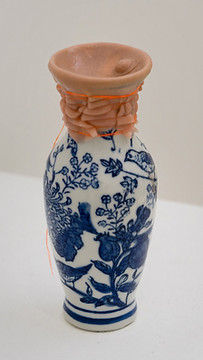M(O)THERED MEAT

Sp-lit (2023), Ceramic candle holder, fake hair, silicone, cotton wool, stockings, pearl pins
M(O)thered Meat (2023), a solo exhibition that took place at The Backroom KL, interrogates the monstrous feminine within Malaysian folklore to challenge the oppressive patriarchal systems held together by tradition and culture. This rebellion against the systemic misogyny that plagues the Malayan society manifests as the home of a female monster—a collection of visceral assemblages of cultural objects and grotesque bodily sculptures (or what I refer to as ‘monsters’) incorporated into a walkthrough installation that resembles a traditional domestic household.
This project pays homage to the Southeast Asian female monster, the Pontianak, a defiant figure within Malaysian culture that opposes the patriarchal paradigm of the ‘ideal woman’ and the behavioural, physiological and aesthetic expectations of the female body. In this work, I disrupt this narrative by reframing the Pontianak as a symbol of feminist empowerment and rebellion against misogyny by harnessing the abject aesthetic and feminine monstrosity that exists within Malaysian folklore.
I seek to evoke a physiological response within the viewer through the grotesque works (inciting feelings such as repulsion, aversion or empathy) to provoke a personal interrogation into why these works give rise to such a visceral reaction within the viewer. Thus, setting the stage for an internal discourse on the topic of body ideals and forms that sit outside the conventional norms.
The Pontianak’s home incorporates traditional Malaysian household objects and deconstructed elements of her monstrosity. These found objects sit alongside visceral silicone ‘monsters’ which act as sites of trauma to construct politically charged assemblages that address issues surrounding the repressed corporeal female body and women’s rights in Malaysia. These elements, which ordinarily power her monstrosity, are here unravelled and recontextualised, allowing the viewer to perceive the Southeast Asian vampire through an empathetic lens, repositioning the horrific monster as a relatable Malaysian woman.
The boundaries that limit these repressed narratives to women’s private spheres are torn down, bringing much-needed conversations concerning the female body to the public sphere. The viewer is invited to walk through the trauma and the absent narratives of Malaysian women that are embodied within the work, thus provoking a necessary feminist discourse into the systemic misogyny that plagues Malaysian society held in place by tradition and culture.
thered%20Meat%20installation%202(2023).jpg)
Installation of M(O)thered Meat (2023) solo exhibition at The Backroom KL
othred-Meat_ExhView_9.jpeg)
Vagina Party interview installation

Bumbug (2023), silicone, stockings, cotton wool, bum plug

Nipple Vessels series (2023), silicone, stockings, cotton wool, ceramic vases




-a_edited.jpg)
Lilit (2023), silicone, fake hair, sewing needles, cotton wool, stockings

Ponti (2023), silicone, stockings, cotton wool, fake hair, batik, rice, acrylic nails, hair net, foam flower, nail



Kueh Yaz (2023), silicone, sewing needles, dried jasmine flowers, pandan leaf, stockings, cotton wool
An installation touching on female contraceptive tools and the horrendous side effects that have affected myself and people I know personally. Provoking females to do research as these methods effects bodies differently.


Malaysian Vibes (2022), batik, fake hair, silicone, cotton wool, stockings, dried jasmine flowers, meat hook, dog leash, vibrator

Nasi Le, Mak! (2023), fake hair, dried jasmine flowers, silicone, cotton wool, stockings, rice, pandan leaf
Nasi Le Mak (2023), a tragic installation driven by empathy, is centred around women’s rights in Malaysia with a focus on the ruling enforced by the Malaysian government. This rule which states that children born overseas to a Malaysian mother and a foreign father will not be eligible for Malaysian citizenship., Tthus outcasting the Malaysian female body as other and not worthy of holding and continuing the Malaysian blood line.
Why do our female bodies and the blood running through our veins hold no power?
The installation which spans the length of a long wall in the exhibition space incorporates two silicone monsters that act as othered bodies representing a mother and her child. I focused on evoking the feeling of loss, separation and longing in the audience to capture what is felt by the victims of this ruling.
Nasi Le, Mak! (2022) is a response to this unjust verdict which rendered countless Malaysian families stranded across the world. I began tackling this emotional piece by researching traditional Malaysian cuisines, using food as a way to translate and transmute this topic due to how mealtime in Malaysia is an everyday ritual that encourages the family unit to gather and connect through this shared experience. I came across a folklore on how Nasi Lemak, the Malaysian national dish consisting of coconut rice, sambal, egg and fried anchovies served on a pandan leaf, came to be. It was told that the national dish was created in a small village in the home of Mak Kuntum and her daughter, Seri (Intercontinental). Seri accidentally spills coconut milk in a boiling pot of rice. When confronted by Mak Kuntum, Seri replied “Nasi le, mak!” (rice, mother!)
I found this to be a touching story of the bond between mother and child which became the anchor for a discourse on the pressing issue of this prejudiced ruling.
There is a stripping of one's cultural identity realised in the colourless blob, representing a child cradled by jasmine flowers, and a pandan leaf in search of its home through its outstretched tendrils of hair. This journey is interrupted by a gap that appears before it is able to reach the colourful yet bruised monster representing its mother who lies restlessly on a bed of dishevelled coconut rice. The national dish is incomplete on both sides requiring the mother and child to be reunited for the dish to be whole. This work acts as a way to create awareness surrounding this issue by employing the public to view the situation from the perspective of the victims.